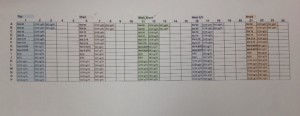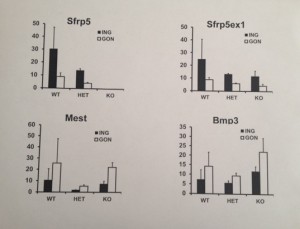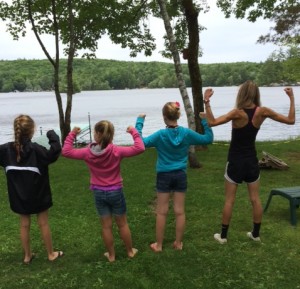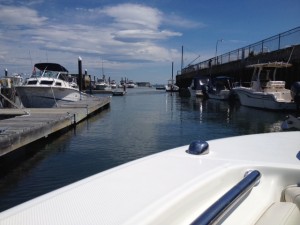I’m settling in quite well and I’m having a lot of fun.
Click here for a video! —> Me Pipetting
Last week, we left off with NanoDropping the RNA samples. We ended up with a large quantity of RNA without many contaminants, which is very good! We did some quick calculations so that we could dilute the samples to be the same concentration, and then prepared them for the QRT-PCR machine.
The QRT-PCR machine is like the PCR (which I explained in a previous post), except that it’s for RNA instead of DNA. Put simply, the main difference is that in the QRT-PCR, the RNA is converted to DNA before being replicated. QRT-PCR stands for Quantitative Reverse Transcriptase Polymerase Chain Reaction. The “Polymerase Chain Reaction” part refers to the DNA replication, which I explained before. Reverse Transcriptase is what converts the RNA samples to DNA. The Quantitative part of means that the machine uses the rate at which the DNA replicates to calculate how much RNA is in each sample. This is the important part because quantifying RNA is a good way to determine gene expression, which is what Rob is interested in.
Normally, in the body, a short sequence of DNA is converted to RNA, which is then used as a recipe to create a protein that will carry out a function in the body. A gene can’t really do anything unless it is used to make a protein, so this process needs to happen in order for the gene to actually be expressed. The protein is the thing that actually carries out an active function. Therefore, if there is lots of RNA that codes for a certain gene, that means that this gene is likely being highly expressed because it indicates that the DNA is being converted to RNA to make proteins. The QRT-PCR is useful because it tells us how much of a certain RNA is in each mouse so that we can see the differences in gene expression between the mice.
It took a day to prepare the RNA samples for the QRT-PCR. We had to put primers and enzymes and whatnot in each sample, just as we did with the PCR before. We had a plate with a bunch of little wells in it. In each well, we put a few microliters of each sample, and then put the plate into the machine. We had to make a chart that showed us what to put in each well so that we could keep track of all the different samples! We used a plate that had 384 wells on it, so the chart was very helpful!

This is the chart we used so that we would know where to put each RNA sample. Each cell in the chart represents a well.
Because there were so many wells to fill, it would not be efficient to use a manual pipette with one tip. So instead, we used an electronic pipette with an entire row of tips so that we could fill a whole row all at once! It was very difficult and scary to use, and I ended up spilling some of the sample. Rob seemed pretty annoyed and exasperated with me because I messed up, and I felt really bad, but luckily it didn’t really ruin anything. Click the link below to see a video of Rob using the big pipette to put the RNA samples onto the plate!
After getting the data from the QRT-PCR, we used Excel to do some calculations, organize it, interpret it, and make sure that the results didn’t have any errors. That part was pretty easy. Rob showed me how to do it, and then he let me and the other intern work together to finish it off.

These were the results that Rob helped me analyze from the QRT-PCR! He made the top two graphs, and I made the bottom two graphs on my own.
Today, Rob and I worked on something completely different. Because the other intern wasn’t here, I did what he normally would have done. We isolated plasmid from bacteria. Plasmid is basically DNA, but instead of just being a long chain, it is a circle. The process of isolating it was pretty similar to isolating DNA or RNA, so the procedure went quickly and smoothly because I had done similar things before. After isolating the plasmid, we used the NanoDrop to determine the concentration of each sample, just as we had done previously with the DNA and RNA. We used the concentrations to calculate how much plasmid we had, and then we were done! I asked Rob what the bacteria was for, because I wanted to understand the larger context of what we were doing, but I think it was kind of a complicated question because he gave me a very watered-down answer. He said that this bacteria is in demand because it’s used in gene research, which is a hot field right now, and so he was simply making more of it to give to people so that the world doesn’t run out.
That’s basically all I did in the lab this week!
Last Friday night, I went to a BBQ for the local high school girls’ cross country team. It was hosted at the captain’s house, and I had a really great time! I was pretty scared to go because I didn’t know anyone, but all the girls were really nice, and I think I’ll be hanging out with them a lot during my free time! It was a great way to meet some girls my age who share my interest in running. I hung out with them again last night, and then this morning we all went for a run together and then had breakfast after! We just took it easy on the run, and it was a great way to start the day. I had a lot of fun, they’re a great group of girls. I think I’m going to run with them twice a week.
Last Saturday, my host family and I went to my host dad’s parents’ house that they have by a little lake. That was really fun. I kayaked around the lake, and then we took a canoe to the center of the lake where there was this big rock you could jump off of into the water!
On Sunday, my host family’s friends invited us to come for a ride on their boat, which was awesome! We rode out into the ocean, and I jumped off the side of the boat which was fun. The water was 64 degrees, so I didn’t stay in the water long!
Here is a video of me jumping into the ocean! —> Boat Jump
Well that’s all for now! I do miss the mountains, what with their gorgeousness and complete lack of humidity and whatnot, but I have been having a glorious time nonetheless. I can’t believe it’s been three weeks already! It doesn’t feel like I’ve been here long at all. Time is flying by because I’ve been so busy! It’s the best kind of busy, because it’s not even remotely stressful. I’ve just been doing something fun during all of my waking hours, and I’m never bored!



Love it, Binie! The videos are excellent — they really help me see what it’s like there for you!! And your explanations of your work were well done. I feel like I clearly understand. I love you!
Written like a graduate student’s masters thesis; beautiful work. Your aunt Kelly is the contact if you need further assistance understanding ribonucleic acid!
Your dad will be here in Evans Tues night. Will miss seeing you, CW, and your mom. Take care dear girl.
Love, Uncle Brad
Great post Sabine. You are having an amazing experience!
Bine, I don’t even know where to start! First, I can’t get over what you are doing with your summer. You look like a movie star doing a science thriller movie (forgive me, I am reading a Michael Chricton book), but you are really a scientist doing experiments! Incredible!! Also I am amazed at your writing; you do such a great job of explaining what you are doing. I love what an inspiration you are to your cousin ( and me!) and I love seeing your videos. I’m glad you have a nice host family and are having some fun time. I sure love and miss you!!
way to rock that pipetting 🙂
Girl you need to learn to speak English for some of us old dumb folks. Looks like you are having a good time though.
Love You
Buddy
You’re life is so exciting…………
all my love, nana
You’re life is amazing…………You do know that don’t you???
You’re life is amazing. You do know that don’t you. Love you so very much…….Nana
Pingback: ¥ô¥£¥È¥ó ÂÃÐÐ ¥Ð¥Ã¥° ͨØ